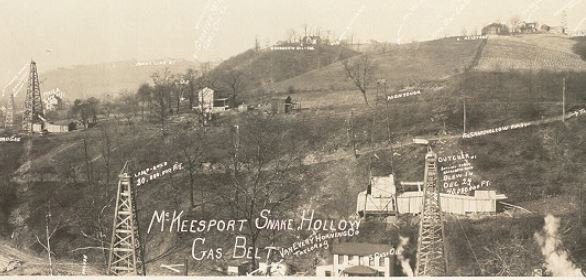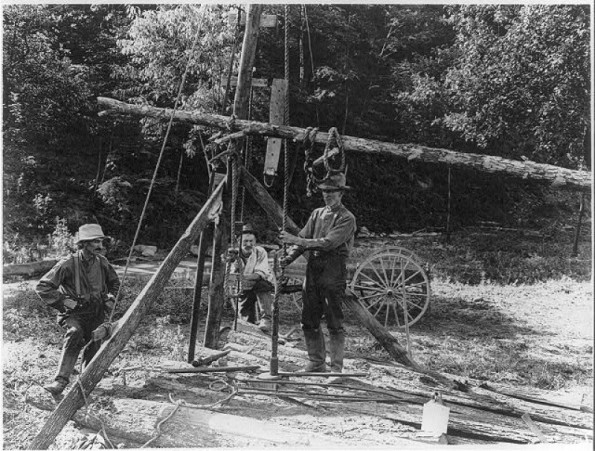August 30, 1919 – Natural Gas Boom (and Bust) in Pennsylvania –
The “Snake Hollow Gusher” of McKeesport, Pennsylvania, revealed a natural gas field that soon attracted hundreds of exploration companies. Drilled near the Monongahela River southeast of Pittsburgh, the discovery well produced 60 million cubic feet of gas a day. The drilling frenzy it inspired resulted in $35 million invested in a nine-square-mile area.

“McKeesport, Snake Hollow, Gas Belt” from a circa 1920 panoramic image by Hagerty & Griffey. Photo courtesy Library of Congress.
“Many residents signed leases for drilling on their land,” the local newspaper reported. “They bought and sold gas company stock on street corners and in barbershops transformed into brokerage houses.”
The excitement ended in early 1921 when gas production declined in 180 wells and more than 440 exploratory wells found no gas. The field was later described as “the scene of the Pittsburgh district’s biggest boom and loudest crash.”
Learn more in McKeesport Gas Company.
August 30, 2002 – Conoco and Phillips Petroleum become ConocoPhillips
Almost 100 years after Frank and L.E. Phillips completed their first oil well and 128 years after Continental Oil delivered its first can of kerosene in a horse-drawn wagon, Phillips Petroleum and Conoco combined to form ConocoPhillips.

An 1880s Continental Oil Company horse-drawn tank wagon welcomes visitors to the Conoco Museum in Ponca City, Oklahoma. The Phillips Petroleum Company Museum is 70 miles east in Bartlesville. Photo by Bruce Wells.
Earlier petroleum companies that played key roles leading to ConocoPhillips included Transcontinental Oil & Transportation, 101 Ranch Oil, Marland Oil, and Continental Oil and Refining.
As part of the 2007 celebration of Oklahoma’s centennial, ConocoPhillips opened oil museums in Ponca City and Bartlesville. When the company separated its refining and marketing businesses in 2012, Phillips 66 again became independent.
August 31, 1850 – San Francisco Utility manufactures Gas from Coal
The San Francisco Gas Company incorporated in 1850 to produce and distribute manufactured gas extracted from coal. Irish immigrants Peter and James Donahue and engineer Joseph Eastland erected a “gasification plant” to distill coal for manufacturing the gas for lighting. Their company illuminated San Francisco’s first “town gas” street lamps in 1852.
Over the next 50 years, the gas company merged with competitors, ultimately becoming Pacific Gas & Electric (PG&E) in 1905. By 1915, there were almost 8,500 San Francisco street lamps — each hand lit and shut off every day. The last coal-gas lamp was extinguished in 1930.
Learn about one of the earliest and largest gas utilities, Consolidated Edison, in History of Con Ed.
August 31, 1859 – U.S. Petroleum Industry’s First “Dry Hole”
Just four days after the first American oil well in Titusville, Pennsylvania, a series of far less known “firsts” were achieved by local entrepreneur John Grandin in August 1859.

A spring-pole similar to the one above was used in 1859 to drill America’s first dry hole, which was deeper than the nearby Drake well. Photo from “The World Struggle for Oil,” a 1924 film by the Department of the Interior.
Grandin drilled using the simple (and ancient) spring-pole “kick down” method at Gordon Run Creek. His well found no oil, but achieved several petroleum industry milestones. His attempt would be credited with the first stuck tool, the first “shooting” of a well with black powder, and first well ruined by a failed shooting attempt.
Learn more in First Dry Hole.
August 31, 1871 – Birth of “The Father of Route 66”
Cyrus Stevens Avery, an Oklahoma independent producer who became known as “The Father of Route 66,” died in Los Angeles at age 91. After moving to Oklahoma in 1897, Avery sold life insurance in Oklahoma City before starting the Avery Oil and Gas Company in 1908, during the Tulsa oil boom.
By 1916, after describing Tulsa as “little town without lights” with “pigs running loose in the streets,” the independent producer “helped lay out a state road plan and the national highway numbering system, becoming the champion of a road from Chicago to Los Angeles we know as Route 66,” according to the Tulsa Historical Society (THS).
September 1, 1862 – Union taxes Manufactured Gas
To help fund the Civil War, a new federal tax was placed on manufactured gas, a popular fuel for street and residential lighting. Manufactured gas (produced from coal) was taxed up to 15 cents per thousand cubic feet. The Brooklyn Daily Eagle quickly accused the local gas company of passing on the tax, which “shifts from its shoulders its share of the burdens the war imposes and places it directly on their customers.”
September 2, 1910 – Cities Service Company incorporates
Henry Doherty organized the Cities Services Company as a public utility holding company in Bartlesville, Oklahoma. Doherty bought producing properties in Kansas and Oklahoma as he acquired distributing companies and linked them to growing natural gas supplies.
In 1915, a Cities Service subsidiary discovered the 34-square-mile El Dorado oilfield. In 1928, another subsidiary discovered the Oklahoma City oilfield.

Cities Service Company subsidiaries discovered major Mid-Continent oilfields.
Federal court mandates in 1940 resulted in Cities Service’s divestiture of its public utilities, and in 1959 the remaining companies were reformed as Cities Service Oil Company, which changed its marketing brand to Citgo in 1964.
After being acquired by Occidental Petroleum in 1982, Citgo was acquired by the Venezuela state-owned oil company Petróleos de Venezuela (PDVSA) in 1990.
Learn more in Cities Service Company.
September 2, 1918 – Desdemona Oilfield adds to North Texas Boom
A third oil boom arrived in Eastland County, Texas, when the Hog Creek Oil Company exploratory well at Desdemona blew in at 2,000 barrels of oil a day — thrilling the venture’s investors. Production from the new oilfield, which joined prolific fields at Breckenridge (1916) and “Roaring Ranger” (1917), would peak at more than 7.3 million barrels of oil in 1919.
“By 1919 the Desdemona field was probably the second largest in the oil belt, and the Hog Creek Oil Company’s stockholders were able to sell their $100 shares for $10,250 each,” noted the Edwin T. Cox in his 1950 History of Eastland County, Texas.
Thanks to its oil leases, Eastland County’s Merriman Baptist Church would be declared the richest congregation in America.
September 2, 2009 – Gulf of Mexico Depth Record
BP discovered an oilfield 250 miles southeast of Houston in the Gulf of Mexico — and set a world depth record by drilling 30,923 feet into seabed from a platform floating more than 4,130 feet above.
The Tiber Prospect field — in 2009 estimated to contain more than three billion barrels of oil — was drilled by the Deepwater Horizon, which later was moved to a new site and destroyed in the deadly explosion and oil spill of April 2010. Learn about other ultra-deep wells in Anadarko Basin in Depth.
_______________________
Recommended Reading: McKeesport – Images of America: Pennsylvania (2007); Conoco: 125 Years of Energy
(2000); Phillips, The First 66 Years
(1983); Western Pennsylvania’s Oil Heritage
(2008); Growing Up In The Bradford Oil Fields
(2008); History Of Eastland County Texas (1950); History Of Oil Well Drilling
(2007). Your Amazon purchase benefits the American Oil & Gas Historical Society. As an Amazon Associate, AOGHS earns a commission from qualifying purchases.
_______________________
The American Oil & Gas Historical Society (AOGHS) preserves U.S. petroleum history. Become an AOGHS annual supporting member and help maintain this energy education website and expand historical research. For more information, contact bawells@aoghs.org. Copyright © 2023 Bruce A. Wells. All rights reserved.


